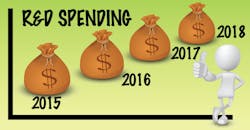R&D Spending Trends: More Innovation On The Horizon!
Download this article as a .PDF
Have you ever wondered how much money is spent on research and product development each year? Or where all the money comes from that enables what we generically refer to as “innovation”? Or how these monies are allocated across basic research, applied research, advanced development, and product development? Probably not. Most practitioners are mostly concerned with whether their budgets will be cut or increased. “Up or down is what I need to know,” holds true whether one is innovating in academia, government laboratories, for-profit companies, or makers funded by venture capital.
Information Sources: There are two primary sources of funding information. The first is the Business Research and Development Innovation Survey (BRDIS), a survey conducted annually by the Census Bureau for the National Center for Science and Engineering Statistics (NCSES), which is part of the National Science Foundation.
Enacted into law in 2010, the NCSES is the official Federal clearinghouse for collecting, interpreting, analyzing, and disseminating objective data on science, engineering, technology, and research and development. Importantly, NSF tracking is not new; predecessor organizations complied this information for many decades. Although data is collected each year, it takes roughly two years to assemble it into a comprehensive report—which typically comes out in August. In August 2017, the report for 2015 was released.
The second source is the Global R&D Funding Forecast (GFF) published by R&D Magazine for the last 60 years. GFF’s goal is to make a projection at the end of each year on the R&D monies that will be spent the year ahead. The full GFF typically comes out early in each new year. It is the only consistently produced report that looks ahead.
Noisy Data: This is a terribly complicated subject. There are a gazillion sources of funds and a gazillion spenders of funds. Not all spenders are public companies. Many private companies do not track R&D unless there is an active tax credit law. Tax credit laws come and go. I’ve followed both sources for some 15 years. As best I can tell, there is a different counting method as the GFF forecast seems to be two percentage points lower in projection versus what the NCSES ends up counting three years later. Why? Does the government give GFF researchers accurate figures on planned spending? Perhaps it is a matter of national security. Will academic and corporate sources reveal their true plans in advance, alerting competitors early on to increases? Maybe yes, maybe no. So, in this sense, the noise limits a practitioner’s view to simply looking at whether spending is up or down.
Spending Trends: Although Machine Design is a global publication, and there are interesting global trends as China and Scandinavian countries are tearing up the pavement on spending, global is too large a subject for now. Focusing on United States R&D for the nine years after 2010 (when spending returned from a 2008 Great Recession flat line) tells a story. As expected, there was optimism as folks thought the economy would rebound quickly. That optimism gradually decreased until the economy began to rebound, then the optimism returned. Here is the nine-year GFF sequence from 2010 to 2018: 3.2%, 2.4%, 2.8%, 1.9%, 1.0%, 3.2%, 3.4%, 2.9%, and 2.9%.
Real Money: According to the R&D Magazine 2017 Survey for the 2018 GFF, $553 billion will be spent on R&D in the U.S. this year—more than a half-trillion dollars. The Federal Government and other government agencies will spend $144B. Industry will spend $367.7B. Academia will spend $20.5B. And Non-Profits will spend $20.8B.
Observations: First, given that inflation has remained low, the growth in R&D spending over each of the past four years represents a real spending increase. Second, noting that only 75 to 78% of these monies go to product development and the rest to basic and applied research, and if time-to-market is 2 to 4 years, then product plans and pipelines have been steady now for 1 to 2 product cycles. Third, all current public economic forecasts predict continued growth, indicating that businesses and consumers will have predictable purchasing power. Taken together, this indicates the next few years will be great for engineers and scientists who innovate and invent. And businesses and consumers will have a steady wave of new products to consider.
About the Author
Bradford Goldense
Contributing Technical Expert
Bradford L. Goldense is founder and president of Goldense Group, Inc. [GGI] (www.goldensegroupinc.com), a consulting, market research, and education firm focused on business and technology management strategies and practices for product creation, development, and commercialization. He has been an adjunct faculty member of the graduate engineering school at Tufts University's Gordon Institute for 19 years. Goldense is a Certified New Product Development Professional [NPDP], a Certified Manufacturing Engineer [CMfgE], a Certified Computer Professional [CCP], and is Certified In Production & Inventory Management [CPIM]. He holds over 200 registered copyrights and is a recognized subject-matter expert, including appearances on PBS and CNBC. He has consulted to over 250 companies and over 750 manufacturing locations on four continents since founding GGI in 1986. Goldense holds an MBA in Accounting from the Cornell Johnson School and a BSCE from Brown University. For more information, please see Brad's LinkedIn profile or visit GGI's home page.

